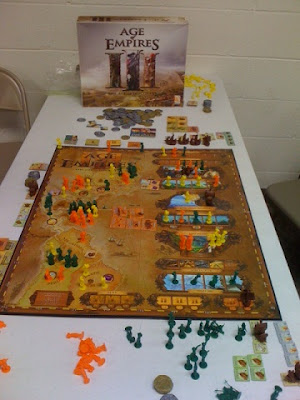One of the worker placement games that I have kept in my collection for a while now is Age of Empires III
Age of Empires III is played in 3 different Ages. At the end of each Age, the players will score points based on how many colonists they have in the new world (and the available buildings will change and go up in price). On any given turn, the players will take turns placing colonists or specialists (if they have any) in order to gain the most victory points. They can use them to gather trade goods, improve their turn order, send them to the new world, discover new locations, and a few other things. The specialists can be placed just like colonists, but if utilized in certain places, they will give extra bonuses (for example, if a Merchant goes to the new world, the player who controls him will get $5). After all of the units have been placed, the board is resolved from top to bottom. Play continues like this for 8 turns (which is 3 Ages), and then the players add any bonus victory points they have from discoveries, buildings, etc, and the player with the most victory points is the winner.
 |
| Getting specialists for next turn. |
The next thing that I like about Age of Empires III is how the placement works. (This is related to the specialists.) In Age, players take turns placing units (colonists or specialists) until they run out. This allows a player with a large number of specialists to get several placements in a row after the other players have all run out of units; this can be a very powerful thing to do. Whereas some places on the board reward the first player to place there (such as trade goods and purchasing buildings, because the first person there gets to pick first), other places reward the person with the most units. If you are the only person placing units at the end of the turn, it allows you to easily take over all of these places.
 |
| Fighting for a merchant ship |
My cons to Age of Empires are fairly minor. The first one that is almost too trivial to mention is that the box is too big. The board folds up quite nicely, and then fits in about 3/4 of the box. This is one of those things that you don't realize that you miss until it's gone; I really like my board fitting snugly inside the box.
The next con with Age of Empires is that the buildings aren't all balanced. Now, this may be on purpose to encourage players to want to be the first one in the building area (thus getting first pick), but it can really punish players for going last at the beginning of the game. And one specific building seems especially overpowered - it is an Age I building (thus costing $10, which is the amount you start with), and it gives you $20... so basically, it allows you to purchase 2 more buildings on the turn you buy it. None of these buildings are single-handedly so powerful that you cannot win without them, but they are powerful enough that you feel that you have a disadvantage by not purchasing them.
Overall, I give Age of Empires III a 9.0/10. As I said at the beginning, I was very reluctant about the game because board games based off of video games are often atrocious, but this game pleasantly surprised me - I plan to keep it in my collection for years to come.
Other worker placement games that you may be interested in include Caylus, Stone Age, and (not completely "worker placement", but still very good) Princes of Florence.

I love this game. I'm glad to see that it's being rebranded - I've always thought that the video game license didn't really do anything for it to begin with, and now it appears that it's been holding up the expansion for some time now. Great review.
ReplyDelete